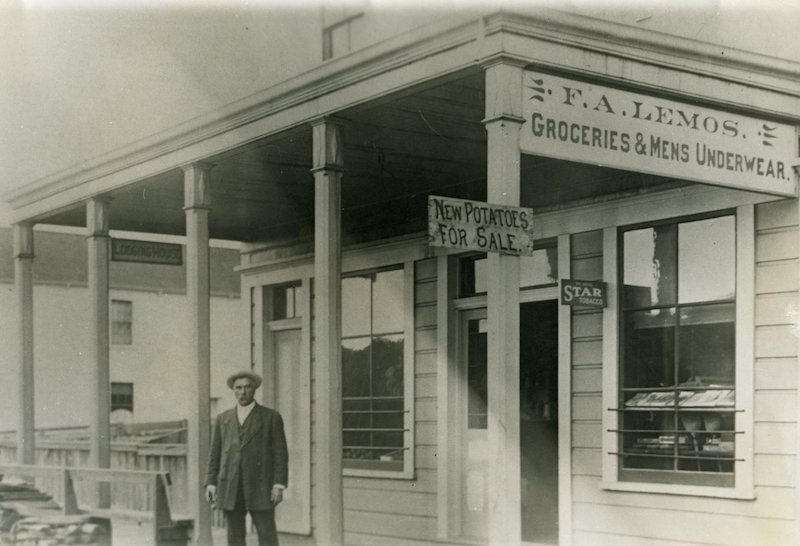Did you know that Mendocino City went “dry” ten years before the rest of the USA? In the summer of 1909, the voters (men) of Mendocino decided to eliminate the sale of liquor. It can be said that Mendocino was a small town with a large drinking problem, and the number of voices speaking against the evils of alcohol had increased. While this decision made temperance workers, churchgoers and businessmen happy, it distressed the common people who liked their beer or wine, as well as the owners of the local saloons, which were forced to close overnight.

The “dry” option vote in 1909 forced Fernando Lemos to convert his saloon and boarding house into a grocery store.
Not surprisingly, during the dry 24 years that followed, much illegal spirited refreshment was either produced in Mendocino or smuggled into it. Law enforcement officials took great delight in arresting bootleggers, not least because they always had cash to pay their fines. Raids on stills made great newspaper copy, but smugglers and bootleggers were often the heroes of those stories.
In a January 24, 1914 Beacon story, it was noted that two truckloads of booze taken in recent raids were dumped by Sheriff Byrnes over the bluff into the bay. The law enforcement officers broke heads of casks and smashed whole cases of bottles that were tossed into the water. The odor of liquor filled the air, and spectators were drenched by liquor when fierce gusts of wind blew upon them. The newspaper did not report that townsfolk on the beach below collected the booze in buckets when it came in streams from the bluff top. Town rumor had it that all the fish in Mendocino Bay were pickled.
Then in January 1920, the 18th Amendment to the U.S. Constitution made it illegal to produce, import, transport or sell alcoholic beverages anywhere in the United States, so federal agents joined the county sheriff in searching for law-breakers. A February 20, 1923 Beacon article noted $700 in fines for bootleggers at Justice Murray’s court. In addition, four men from Boyles Camp paid $400 each for having 900 gallons of wine, jackass brandy (distilled from fermented grape juice or raisins), and other liquors in their possession.
On July 16, 1932, the Beacon reported: “A huge still and a large accumulation of materials for making jackass or moonshine booze was uncovered this week by the sheriff’s office. Located in Barton Gulch on the Navarro River near Hop Flat, the plant, worth $15,000, included a 750-gallon still, a 50 horsepower steam boiler, 600 gallons of fuel, 2500-gallon vats, 1000 feet of pipe, and 1000 gallons of alcohol.” The most valuable commodity confiscated was 17,000 pounds of sugar. It would be utilized by the County Poor Farm and distributed to the needy. A big truck, seized during the raid, delivered the sugar inland.
When prohibition was repealed in 1933, the articles in the Beacon became much less exciting.
The Kelley House Museum is open from 11AM to 3PM Thursday through Monday. If you have a question for the curator, reach out to curator@kelleyhousemuseum.org to make an appointment. Walking tours of the historic district depart from the Kelley House regularly.